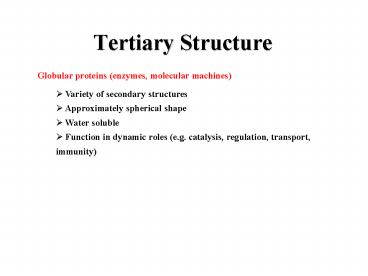Tertiary Structure - PowerPoint PPT Presentation
1 / 11
Title:
Tertiary Structure
Description:
Tertiary Structure. Globular proteins (enzymes, molecular ... Recent discovery that amyloid diseases (eg. CJD, Alzheimer) are due to unstable protein folding ... – PowerPoint PPT presentation
Number of Views:23
Avg rating:3.0/5.0
Title: Tertiary Structure
1
Tertiary Structure
- Globular proteins (enzymes, molecular machines)
- Variety of secondary structures
- Approximately spherical shape
- Water soluble
- Function in dynamic roles (e.g. catalysis,
regulation, transport, immunity)
2
Tertiary Structure
- Fibrous Proteins (fibrils, structural proteins)
- One dominating secondary structure
- Typically narrow, rod-like shape
- Poor water solubility
- Function in structural roles (e.g. cytoskeleton,
bone, skin)
3
Tertiary Structure
- Membrane Proteins (receptors, channels)
- Inserted into (through) membranes
- Multi-domain- membrane spanning, cytoplasmic,
and extra-cellular domains - Poor water solubility
- Function in cell communication (e.g. cell
signaling)
4
Quaternary Structure
- Definition Organization of multiple chain
associations - Oligomerization- Homo (self), Hetero (different)
- Used in organizing single proteins and protein
machines - Specific structures result from long-range
interactions - Electrostatic (charged) interactions
- Hydrogen bonds (O?H, N? H, S ? H)
- Hydrophobic interactions
- Disulfides only VERY infrequently
5
Quaternary Structure
The classic example- hemoglobin a2-b2
6
Protein Folding
- Folded proteins are only marginally stable!!
- 0.4 kJmol-1 required to unfold (cf.
20/H-bond) - Balance of loss of entropy and stabilizing
forces - Protein fold is specified by sequence
- Reversible reaction- denature (fold)/renature
- Even single mutations can cause changes
- Recent discovery that amyloid diseases (eg. CJD,
Alzheimer) are due to unstable protein folding
7
Protein Folding
- The hydrophobic effect is the major driving force
- Hydrophobic side chains cluster/exclude water
- Release of water cages in unfolded state
- Other Forces stabilizing protein structure
- Hydrogen bonds
- Electrostatic interactions
- Chemical cross links- Disulfides, metal ions
8
Protein Folding
- Random folding has too many possibilities
- Backbone restricted but side chains not
- A 100 residue protein would require 1087 s to
search all conformations (age of universe lt 1018
s) - Most proteins fold in less than 10 s!!
- Proteins fold along specific pathways
9
Protein Folding Pathways
- Usual order of folding events
- Secondary structures formed quickly (local)
- Secondary structures aggregate to form motifs
- Hydrophobic collapse to form domains
- Coalescence of domains
- Molecular chaperones assist folding in-vivo
- Complexity of large chains/multi-domains
- Cellular environment is rich in interacting
molecules? Chaperones sequester proteins and
allow time to fold
10
Relationships Among Proteins
- I. Homologous very similar sequence (cytochrome
c) - Same structure
- Same function
- Modeling structure from homology
- II. Similar function- different sequence
(dehydrogenases) - One domain same structure
- One domain different
- III. Similar structure- different function (cf.
thioredoxin) - Same 3-D structure
- Not same function
11
Relationships Among Proteins
- Many sequences can give same structure
- Side chain pattern more important than sequence
- When homology is high (gt50), likely to have
same structure and function (structural genomics) - Cores conserved
- Surfaces and loops more variable
- 3-D shape more conserved than sequence
- There are a limited number of structural
frameworks






























